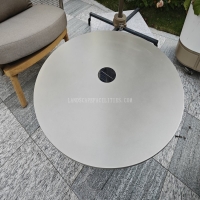Welcome to the website for landscape facilities products and knowledge.
How does the choice of a built-in versus freestanding design impact the resale value of a landscape bar counter?
When designing an outdoor entertaining space, homeowners often face a crucial decision: should they install a built-in landscape bar counter or opt for a freestanding model? This choice goes beyond mere aesthetics and functionality—it significantly impacts property value and appeal to future buyers. Built-in bar counters, typically constructed from durable materials like stone, brick, or weather-resistant cabinetry, create a permanent, high-end outdoor kitchen feel. They signal a substantial investment in the property's infrastructure, often appealing to buyers seeking turnkey luxury outdoor living spaces. However, this permanence can also be a drawback; built-ins are expensive to install (anywhere from $5,000 to $20,000+) and even more costly to remove or alter if a new owner has different tastes or needs. Their value is intrinsically tied to the current trend of elaborate outdoor rooms and requires a buyer who specifically desires that feature.
Conversely, freestanding bar counters, made from materials like teak, stainless steel, or synthetic wicker, offer remarkable flexibility. Their lower initial investment (often $1,000 to $4,000) and portable nature are significant selling points. A potential buyer can easily envision relocating the unit or taking it with them if they move, making it an attractive, low-commitment feature. This flexibility broadens its appeal. However, freestanding units may be perceived as less premium or durable compared to a custom-built structure. They can suggest a temporary solution rather than a permanent upgrade to the property itself.
The impact on resale value is therefore nuanced. A well-executed built-in bar that seamlessly integrates with the home's architecture and landscaping can substantially increase perceived value and justify a higher asking price, particularly in markets where outdoor living is a key driver. It's seen as a fixed asset. A freestanding bar doesn't typically add direct monetary value to the real estate appraisal but enhances marketability by staging the outdoor area for entertainment, effectively helping the property sell faster. Ultimately, the best choice depends on your local market, your home's overall value, and how long you plan to stay. For maximum resale advantage, a built-in design should be high-quality and universally appealing, while a freestanding model should be stylish and highlight the potential of the space without limiting the buyer's imagination.
Related search:

Recommendation
Outdoor stainless steel table with solar-powered ambient lighting feature - excellent design.